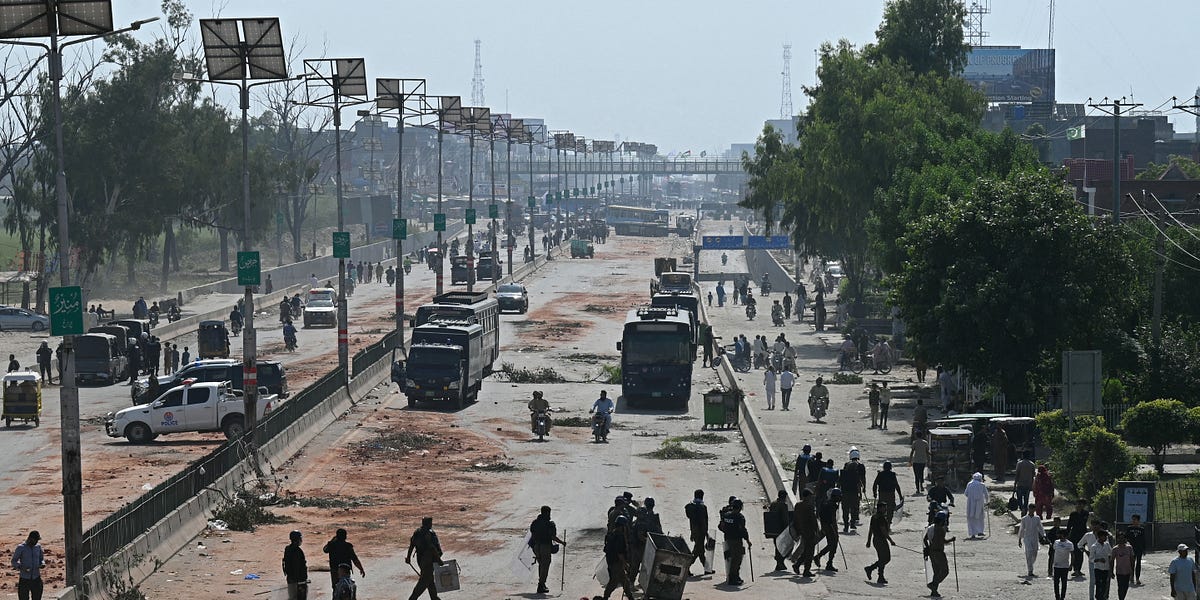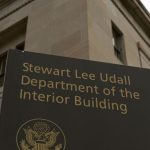On Breaking Points yesterday, we covered the grisly massacre that unfolded this week in Pakistan, as state security services gunned down an unknown but considerable number of people marching to protest against looming normalization with Israel. The segment was controversial, with critics arguing that the group in question, the TLP, is not genuinely “pro-Palestine” but is a far-right, religious extremist organization that regularly incites and carries out violence. But we noted all that in the report.
Pakistan does not actually have a history of this sort of mass state violence, and so the military-backed government needs to normalize it if it is to become part of their weaponry in building and defending what Field Marshall Asim Munir describes privately as his end goal, “a hard state.” Authoritarian governments often target groups with the least public support first, hoping to establish a principle for how other dissent will be dealt with. In this report we document how the Pakistani military appears to be using the same tactic with the justly unpopular TLP to set the tone for how other groups may expect to be treated if they do not toe the line on their emerging Israel-Gaza policy.
The story below, reported by Waqas Ahmed, Murtaza Hussain, and myself, describes one of the most cynical and diabolical deployments of strategic violence I’ve ever covered.
As always, we deeply appreciate your support, which makes this kind of reporting possible.
– Ryan Grim
Drop Site is non-aligned, completely independent, and 100% reader-funded. Every dollar of your support goes directly to our reporting. Please consider making a 501(c)(3) tax-deductible donation today.
As Pakistani Prime Minister Shehbaz Sharif was nominating President Donald Trump for the Nobel Peace Prize—for the second time—during the Gaza “Peace Summit” in Egypt, a large anti-Israel demonstration organized in Pakistan by a religious extremist group normally aligned with the country’s powerful security services was met with a violent crackdown that left scores dead.
Partly in response to growing rumors that Pakistan was on the brink of normalizing ties with Israel, the Tehreek-e-Labbaik Pakistan (TLP), one of the country’s largest religious extremist parties, held a march towards the U.S. embassy in Islamabad against normalization with Israel and in support of Gaza.
“We heard that Pakistan was going to normalize ties with Israel, like UAE has, that is why Saad Rizvi”—the leader of TLP—“decided to march on Islamabad now,” one TLP activist told Drop Site on condition of anonymity. Party leaders believed the march had the blessing of the military-backed government, yet it ended in a massacre.
The TLP has a sordid history inside Pakistan. It first emerged in 2011 in defense of a police commando who assassinated the sitting governor of the province of Punjab, Salman Taseer, over allegations of blasphemy. (The governor’s supposed blasphemy had been to say, “The blasphemy law in Pakistan is a black law.”) Hounding people, or even prosecuting people, for “blasphemy” became one of its central causes; its members have incited violence and even lynchings against people accused of offending its religious sensibilities. The TLP regularly holds demonstrations encouraging the execution or marginalization of religious minorities it perceives guilty of some offense, and those protests have rarely met with any state resistance.
Despite its role in undermining the rule of law in Pakistan—or, perhaps, because of it—the TLP has maintained a close relationship with the Pakistani military and the government. It is widely understood in Pakistan to be a tool of Pakistani intelligence that has been used to incite protests that could serve various domestic political purposes. Only when the group turned critical of the state’s emerging policy towards Palestine did the security services lash out.
The crackdown has elicited little sympathy from many in Pakistani civil society who had justifiably opposed the TLP for its attacks on minorities and enforcement of barbaric blasphemy punishments. But the military turning on one of its own closely-aligned organizations over the subject of normalization with Israel sends a strong message about what could happen to other sectors of society that publicly oppose the widely unpopular move.
Up until October 2025, the TLP had only called for a few small demonstrations in support of Gaza. In early October, it appeared that Pakistan was beginning to play a role in the Gaza ceasefire when the prime minister tweeted in support of Trump’s ceasefire plan as one of the “Muslim countries” supporting the deal. Rumors started circulating that Pakistan would be normalizing ties with Israel. On Friday, after the ceasefire was signed and Sharif traveled to Trump’s Egypt summit, Rizvi announced his plans to march towards the U.S. embassy in Islamabad during his prayer sermon.
Over the weekend, thousands of TLP members gathered from various areas of Punjab and started making their way up on the Grand Trunk Road towards Islamabad. On the outskirts of Lahore, thousands of protestors faced stiff resistance from the police, who fired at the protestors with tear gas.
The march came at a sensitive time for the Pakistani military, which is preparing for the likelihood of renewed war with India, while engaging in an on-again, off-again war with the Taliban on its Afghan border that has presently entered a new ceasefire. Internally, the country’s most popular politician, former Prime Minister Imran Khan, remains behind bars. The military’s need to keep Khan in prison has been deftly exploited by the Trump administration, members of which have flirted with the notion of freeing him. In an Oval Office meeting, Trump even asked his “favorite Field Marshal” to resolve the situation, with Trump citing the support he’d received from Pakistani-American supporters of Khan. In order to fend off a stronger push to free him, the Pakistani military has offered Trump and his family anything they can think of, including support for his Gaza deal, crypto investments, rare earth deposits (that hardly exist), naval support, or a Nobel Peace prize nomination.
But it was Pakistan’s support for Trump’s Gaza deal that threatened domestic stability most significantly. Late on the night of October 12, protestors from the TLP began to rally to oppose the policy, which is widely unpopular among Pakistanis of different backgrounds. Drop Site News was able to reconstruct what happened over the next 48 hours based on an extensive interview with a Pakistani law enforcement official who was closely involved in the operation. His account is corroborated by footage of the violence and its aftermath posted to social media.
Video via the Internet Archive, where several videos from the protests are archived.
The protestors planned to go around and through Lahore, in various convoys, gather further supporters along the way, and make their way slowly north towards Islamabad. TLP is headquartered in Lahore and, according to the law-enforcement official, authorities permitted the procession to pass through Lahore in part because of the risk that reinforcements would swell their ranks if the crowds were blocked inside the city. “There was a real danger of more help arriving in Lahore,” the official said, also emphasizing that many units stationed in the city were reluctant to use force. “The Lahore detachment was wholly averse to violence – they refused to follow orders to escalate,” the official said, describing unsuccessful attempts to contain the march at Shahdara Bridge, where security forces tried to encircle the convoy.
On Sunday night, Pakistani Interior Minister, Mohsin Naqvi, visited the site of the protest. While the protests were outside of his jurisdiction, Naqvi is unofficially the closest advisor to Pakistan’s de-facto ruler Field Marshall Asim Munir. His presence indicated that Munir was taking a close interest in the situation.
The protestors were funneled toward a predetermined area while passing through the city of Muridke, around 20 miles north of Lahore, the official said. In Muridke, the protestors were unable to move forward because the local administration had created barriers on the main road. The protestors decided to stage a sit-in, but their vehicles had been trapped from both sides. He added that the Muridke site was chosen in part because of its local demographics and sectarian dynamics, making it difficult, he said, for TLP supporters to find local backing.
At this point, late into Sunday night, Rizvi started asking local authorities to negotiate a de-escalation over a loudspeaker. Those requests were effectively rebuffed—in large part because, the official said, security command had already authorized them to use lethal weapons. Rizvi appointed a delegation of negotiators to speak with the security forces. They were arrested. He appointed a second delegation that likewise failed to make headway. “Rizvi kept pleading for negotiations until the last moment,” the source recounted.
A Pakistani intelligence source told Drop Site News that prior to the protests, a meeting was held at Inter-Services Intelligence headquarters in Islamabad, where a senior general directed the Lahore sector commander to instigate a TLP march toward Islamabad to demonstrate public opposition outside the U.S. Embassy to any move recognizing Israel. The source said the plan included stopping the procession en route and using lethal force to deter future protests.
The police and a contingent of Pakistan Rangers, a paramilitary security force, meanwhile, were closing in. During the commotion that ensued, a TLP member, whom the official identified by the name of Osama, climbed on top of a police vehicle. Multiple shots rang out and the man fell to the ground. A policeman sitting in the vehicle was also hit. That police officer was later declared dead, and identified as Inspector Shehzad Nawaz, of Factory Area Police Station. As Osama fell to the ground, another police vehicle drove over his head, instantly killing him. The photo of Osama’s mangled face later went viral on social media.
In the early hours of Monday morning, the rangers started firing from all directions. According to the source, when some policemen refused to shoot at the protestors, the Rangers shot them in the legs. TLP members on the frontlines were hit by the hail of bullets, with at least five bleeding to death; others were dragged back into the crowds. People tried to help some of the fallen but no ambulances could access the protestors. Pakistan government officials did not respond to requests for comment.
As the firing continued over the next several hours, the crowds panicked and began to disperse. According to eyewitness testimonies, photos, and videos available to Drop Site News, as the protestors ran into the narrow streets of Muridke, the police and rangers pursued and hunted them with the intent to kill. At least three people were shot from behind and killed in one of these narrow streets. A viral video shows one protestor crying in the street, screaming for help beside a dead body. In another video, two policemen can be seen pursuing a running man and shooting in his direction. Yet another shows a police vehicle trying to run over protestors as shots ring in the background.
Amid rumors that Rizvi himself had been shot, the rangers swooped in and took him and his brother into custody. A source close to the TLP leader confirmed this, saying Saad Rizvi had been shot and was under military’s custody. His wife and family are also in separate custody.
Rizvi remained in custody as of Thursday, though the Pakistani government still has not made a public statement about his arrest. The source close to Rizvi said the TLP leader had been hesitant to proceed with the protests, but proceeded after someone with authority provided him assurances that he would be protected and that the action would not run afoul of the Pakistani military establishment. The TLP has a history of conducting street demonstrations on the order of the Pakistani military establishment to help it achieve its own political objectives, and had carried out smaller rallies criticizing Israeli actions in Gaza during the two years of the genocide.
The current crackdown on the TLP comes as the military prepares the groundwork for likely recognition of Israel despite the unpopularity of such a move among most segments of Pakistani society, including its own religious-nationalist base. The law enforcement officer involved in the crackdown on the TLP hypothesized that internally the government may have wanted to generate an atmosphere of fear and uncertainty prior to any formal steps toward recognizing Israel in order to suppress future protests.
One piece of evidence supports that claim: in a highly unusual move, Pakistan’s military-aligned media aired coverage of the violence, including an interview with a local man who claimed he saw more than 600 dead bodies. Such a claim would never be aired on that network without approval from the military, suggesting the establishment wanted to send a message to the people of Pakistan, without raising an international outcry. So far, it is working.

By Monday morning, the protest was reduced to fire, rubble, and scattered dead bodies. No independent source has been able to verify the number of dead, though some estimates have claimed hundreds of casualties. TLP sources have also been unresponsive as the party’s head of social media, Ghazi Furqan, was also killed during the protests.
“The police carried away most of the dead bodies in the dark under the cover of tear gas, like trash, in a large truck,” the Pakistani security official who spoke to Drop Site said. Witnesses had made a similar claim about a separate November 26, 2024 massacre, when the Pakistani government and military cracked down on Khan’s supporters in Islamabad in a similarly violent operation.
According to the official, the bodies of dead TLP supporters are being handed back to their families only under the condition that they hold muted funerals, with less than 30 people. There have also been reports that the homes of some of the dead TLP members are being raided by the police to discourage them from arranging politicized funerals.
Despite years of political violence and turmoil, violent crackdowns on protests at this scale and regularity are unprecedented in Pakistan. The use of live bullets as a tool of crowd dispersal, as well as home raids, attacks on funerals, and kidnapping and torture of civilians have become normalized under the current miltary-backed regime, which has worked hard to curry favor with the Trump administration.
Earlier in the month, another pro-Palestine protest leader from a different party, Jameel Behram, was abducted by unknown law enforcement agents from his home in Karachi’s Malir district. His family’s Instagram account reported that Behram was picked up by security forces at 1:00 a.m. on October 3, 2025, near his house. Behram is still missing and has neither turned up nor has he been made to appear in a court. From the government, there is no explanation about the crimes he has been charged with.
Behram’s last post on X before his abduction called out the government’s endorsement of Trump’s Gaza plan.
First Appeared on
Source link












